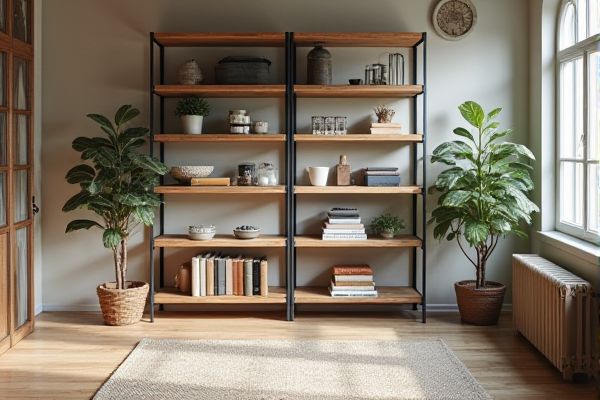
Heavy-duty shelving supports significantly more weight and is ideal for warehouses or industrial settings, while light-duty shelving suits home use or smaller storage needs with lower weight requirements. Discover which shelving type best fits Your space and organizational goals by exploring the rest of this article.
Table of Comparison
| Feature | Heavy-Duty Shelving | Light-Duty Shelving |
|---|---|---|
| Weight Capacity | Up to 2,000 lbs per shelf | Up to 200 lbs per shelf |
| Material | Steel, reinforced metals | Plastic, thin metal, wood |
| Use Case | Industrial storage, warehouses, heavy tools | Office supplies, home organization, lightweight items |
| Durability | High resistance to wear and heavy load | Low to moderate, suitable for light loads |
| Cost | Higher initial investment | More affordable |
| Assembly | Heavy, often requires tools | Lightweight, easy to assemble |
| Typical Dimensions | Deeper and taller shelves, 24-72 inches height | Smaller scale, 12-48 inches height |
| Adjustability | Highly adjustable shelving heights and configurations | Limited adjustability |
Introduction to Shelving Types
Heavy-duty shelving is designed for industrial and commercial use, supporting loads typically over 800 pounds per shelf, ideal for warehouses and manufacturing environments. Light-duty shelving supports lighter loads, generally up to 300 pounds per shelf, suitable for residential or office storage. Material differences impact durability, with heavy-duty options often constructed from reinforced steel, while light-duty shelves utilize lighter metals or plastic composites.
What Defines Heavy-Duty Shelving?
Heavy-duty shelving is defined by its enhanced load capacity, typically supporting weights exceeding 800 pounds per shelf, making it ideal for industrial and commercial storage applications. Constructed from robust materials like thick gauge steel with reinforced beams and supports, heavy-duty shelving ensures durability and stability under extreme weight conditions. Unlike light-duty shelving, which caters to lighter items and less rigorous use, heavy-duty shelving is engineered to withstand heavy impacts and frequent handling in warehouses, factories, and large-scale inventory environments.
Key Features of Light-Duty Shelving
Light-duty shelving is designed for storing smaller, lighter items with weight capacities typically ranging from 100 to 300 pounds per shelf, making it ideal for home offices, garages, or retail displays. Features include adjustable shelves, often made of plastic or thin metal, easy assembly, and a focus on maximizing space efficiency without the need for heavy structural support. You benefit from lightweight construction and versatile configurations that accommodate frequent access and quick organization of everyday items.
Weight Capacity Comparison
Heavy-duty shelving typically supports weight capacities ranging from 800 to over 4,000 pounds per shelf, making it ideal for industrial storage and warehouses. Light-duty shelving generally holds between 100 to 300 pounds per shelf, suited for residential or office use with lighter items. Choosing shelving based on weight capacity ensures safety, durability, and efficient space utilization tailored to specific storage needs.
Materials: Durability and Construction
Heavy-duty shelving is constructed from reinforced steel or heavy-gauge metal, offering superior durability and load-bearing capacity suitable for industrial environments. Light-duty shelving typically uses lighter steel or aluminum with thinner gauge materials, designed for residential or office use with moderate weight limits. The robust construction of heavy-duty shelving ensures resistance to bending and wear, while light-duty shelving prioritizes ease of assembly and flexibility for less demanding storage needs.
Installation and Assembly Differences
Heavy-duty shelving requires robust installation with anchored support brackets and reinforced beams to handle higher weight capacities, often necessitating professional assembly or specialized tools. Light-duty shelving involves simpler installation processes, using lightweight materials and basic fasteners or clips, allowing for easy, often tool-free assembly suitable for home or office use. The structural complexity and required anchoring systems distinguish heavy-duty shelving from light-duty variants, impacting both setup time and required expertise.
Cost Efficiency: Heavy-Duty vs. Light-Duty
Heavy-duty shelving offers superior cost efficiency for warehouses handling bulky or heavy items by reducing the need for frequent replacements and repairs, despite a higher initial investment. Light-duty shelving provides a budget-friendly solution for lighter loads, but increased wear and tear may lead to higher long-term maintenance costs. Selecting the appropriate shelving type depends heavily on load capacity, frequency of use, and overall durability requirements to optimize cost efficiency.
Ideal Use Cases for Each Type
Heavy-duty shelving is ideal for industrial warehouses, automotive storage, and construction materials, supporting loads exceeding 800 pounds per shelf with durable steel frames. Light-duty shelving suits retail displays, home organization, and office supplies, typically holding up to 150 pounds per shelf with materials like plastic or lightweight metal. Choosing the appropriate shelving depends on load capacity needs, space constraints, and the type of items stored to ensure safety and efficiency.
Maintenance and Longevity
Heavy-duty shelving is designed with robust steel frames and durable coatings that resist wear, corrosion, and heavy load stress, ensuring low maintenance and extended lifespan in industrial environments. Light-duty shelving, typically made from lighter materials like plastic or thin metal, requires more frequent upkeep and replacement due to susceptibility to bending and environmental damage. Choosing heavy-duty shelving enhances long-term durability and decreases maintenance costs in high-usage settings.
Choosing the Right Shelving for Your Needs
Heavy-duty shelving features robust construction with steel components designed to support weights typically exceeding 1,000 pounds per shelf, making it ideal for industrial storage or heavy equipment. Light-duty shelving, usually made from lighter materials such as plastic or thin metal, supports up to 250 pounds per shelf and suits environments like offices or retail spaces with lighter inventory. Assessing the weight and type of items you need to store ensures your shelving choice maximizes durability and space efficiency for your specific needs.
 homyna.com
homyna.com